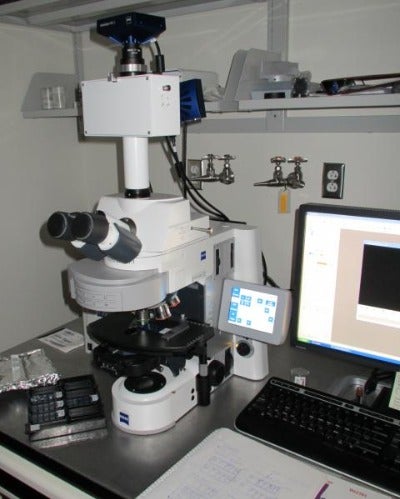
Microscope: Zeiss Axioimager Z2
LOCATION
BRC Room 213B
PRICING
Rice User Fee: $10/hr
Non-Profit Fee: $15.65/hr
For Profit Fee: $50/hr
Rice Training Fee: $20/hr
Non-Profit Training Fee: $31.30/hr
For Profit Training Fee: $100/hr
CONTACTS
Training Contact:
To request training, contact Dr. A. Budi Utama at 713 348 8232 or email budiutama@rice.edu.
Harshavardhan Deshmukh - hd16@rice.edu
Faculty in Charge:
James McNew -Professor of BioSciences
DESCRIPTION
Zeiss Axio Imager Z2 upright microscope is capable to perform epi-fluorescence imaging in combination with transmitted-light brightfield, darkfield and DIC. The system is equipped with series of objectives (2.5X, 5X, 10X, 20X, 40x dry and 63X, 100X oil) with complete DIC sliders and corresponding modules/analyzers. The new 63X water dipping objective just recently purchased (Dec 2013). It also has mechanical stage 75x50R and heavy duty focusing drive motorized (for x,y,z movement) with 10 nm stepsize. A collection of fluoresence filter cubes allow imaging from DAPI to Cy5 region. Two Zeiss cameras are available: AxioCam MRc color camera (12-bit cooled CCD, 2/3” chip size, 6.45 µm x 6.45 µm pixel size, 1388 x 1040 resolution capable to take 14 image/sec frame rate at highest resolution, up to 48 images/sec at lowest resolution) and AxioCam MRm monochrome camera (the same specs as MRc5 but without RGB filter mask). The AxioVison software allows automation of objectives, apertures, filter cubes, illumination, specimen stage, etc. Varies of live-imaging and post-imaging processing/analyses can be performed also interactive measurement, multi-channel and multi-dimensional acquisition (multi point x,y position, Z-stack, image stitching and time-lapse). Transmitted light source: HAL 100 illuminator Reflected light source: Fl Illumination System X-Cite 120 XL FL PC, 120W metal halogenide lamp
ADDITIONAL INFORMATION
Note: The AxioVison software is currently lacked of an advanced deconvolution image processing module. However, it allows deconvolution image to be acquired (with the Z-stage software controlled) and users can process the acquired data using other deconvolution softwares available (ImageJ or FIJI).
